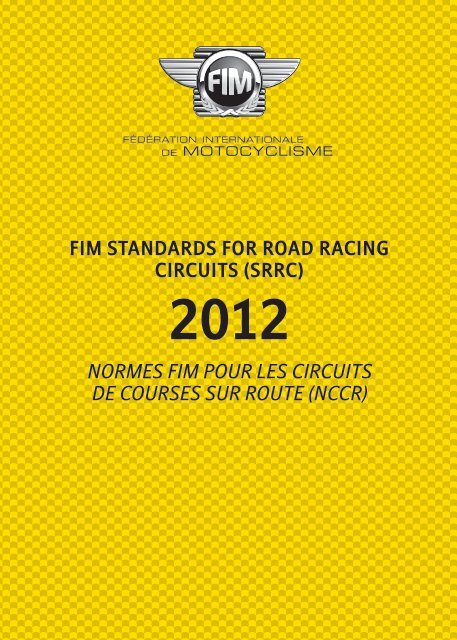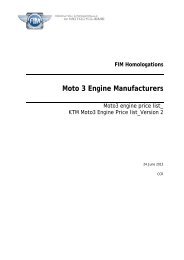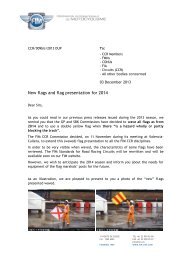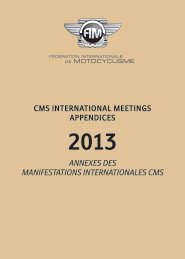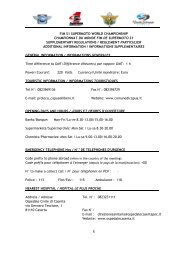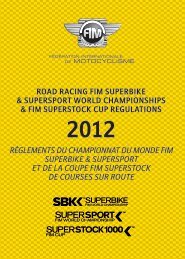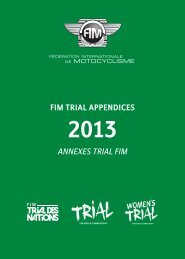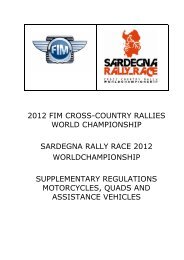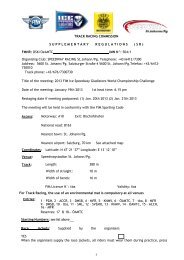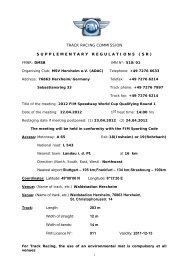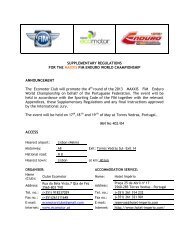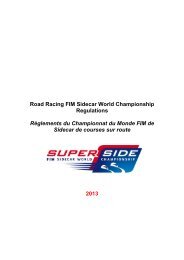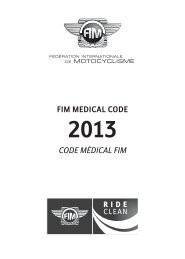FIM STANDARDS FOR ROAD RACING CIRCUITS (SRRC ...
FIM STANDARDS FOR ROAD RACING CIRCUITS (SRRC ...
FIM STANDARDS FOR ROAD RACING CIRCUITS (SRRC ...
Create successful ePaper yourself
Turn your PDF publications into a flip-book with our unique Google optimized e-Paper software.
<strong>FIM</strong> <strong>STANDARDS</strong> <strong>FOR</strong> <strong>ROAD</strong> <strong>RACING</strong><br />
<strong>CIRCUITS</strong> (<strong>SRRC</strong>)<br />
2012<br />
NORMES <strong>FIM</strong> POUR LES <strong>CIRCUITS</strong><br />
DE COURSES SUR ROUTE (NCCR)
FEDERATION INTERNATIONALE<br />
DE MOTOCYCLISME<br />
Normes <strong>FIM</strong> pour les Circuits de<br />
Courses sur Route (NCCR)<br />
<strong>FIM</strong> Standards for Road Racing<br />
Circuits (<strong>SRRC</strong>)<br />
2012
CONTENTS / SOMMAIRE<br />
Annexe 029 Normes <strong>FIM</strong> pour les Circuits de Courses<br />
sur Route (NCCR) .....................................................<br />
Appendix 029 <strong>FIM</strong> Standards for Road Racing Circuits (<strong>SRRC</strong>) .....<br />
Les articles modifiés dès le 01.01.2012 sont en caractères gras<br />
Articles amended as from 01.01.2012 are in bold type<br />
ÉDITION 2012
Table of contents<br />
029.1 GENERAL ...............................................................................4<br />
029.1.1 Object and aims ......................................................................4<br />
029.1.2 Date of application. Changes ..................................................4<br />
029.2 CIRCUIT LAYOUT ...................................................................4<br />
029.2.1 General principles ...................................................................4<br />
029.2.2 Length of the circuit ................................................................4<br />
029.2.3 Straights ................................................................................4<br />
029.2.4 Curves ................................................................................5<br />
029.2.5 Banking ................................................................................5<br />
029.2.6 Banking on straights ...............................................................5<br />
029.2.7 Transition of banking ...............................................................5<br />
029.2.8 <strong>FIM</strong> kerbs for inside and outside of the turns ..........................6<br />
029.3 VERGES AND RUN-OFF AREAS...........................................7<br />
029.3.1 Definition and purpose ............................................................7<br />
029.3.2 Characteristics ........................................................................7<br />
029.3.3 Gravel beds .............................................................................7<br />
029.4 DRAINAGE OF SURFACE WATER .......................................7<br />
029.5 ADDITIONAL PROTECTIVE DEVICES ..................................8<br />
029.5.1 General ................................................................................8<br />
029.5.2 Homologation procedure of new additional protectivec<br />
devices ................................................................................9<br />
1
029.6 SIGNALS AND MARKINGS ....................................................9<br />
029.6.1 Turn signs ...............................................................................9<br />
029.6.2 Start lights ..............................................................................10<br />
029.6.3 Red lights around the circuit .................................................10<br />
029.6.4 Pit-lane exit lights ...................................................................11<br />
029.6.5 Yellow flashing lights around the circuit .................................11<br />
029.6.6 Marking ..............................................................................11<br />
029.7 CIRCUIT INSTALLATIONS AND SUBSTRUCTURE ............12<br />
029.7.1 Riders’ Paddock ....................................................................12<br />
029.7.2 Scrutineering areas ...............................................................15<br />
029.7.3 Pit-lane entry ..........................................................................15<br />
029.7.4 Pits ..............................................................................15<br />
029.7.5 Signalling platform ................................................................16<br />
029.7.6 Pit-lane exit ...........................................................................17<br />
029.7.7 Starting grid ...........................................................................17<br />
029.7.8 Closed park area ..................................................................21<br />
029.7.9 Race control post ..................................................................21<br />
029.7.10 Closed Circuit Television (CCTV)...........................................21<br />
029.7.11 Communications service .......................................................22<br />
029.7.12 Timekeeping post and results office .....................................22<br />
029.7.13 Officials’ rooms .....................................................................22<br />
029.7.14 Press Centre ..........................................................................23<br />
029.7.15 Installations for TV commentators ........................................27<br />
029.7.16 Advertising ............................................................................28<br />
029.7.17 Installations for the public .....................................................28<br />
029.7.18 Circuit maintenance ..............................................................29<br />
029.7.19 Podium ..............................................................................30<br />
029.8 MARSHALS’ POSTS ............................................................30<br />
029.8.1 Number and location ..............................................................30<br />
029.8.2 Protection ..............................................................................30<br />
029.8.3 Equipment of the Flag Marshal’s posts ..................................30<br />
029.8.4 Presentation of the Flag Marshals .........................................32<br />
029.8.5 Position of the Flag Marshals ................................................32<br />
029.8.6 Equipment of the Track Marshal’s posts ................................32<br />
029.8.7 Presentation of the Track Marshals .......................................33<br />
029.8.8 Marshals’ Uniforms ................................................................33<br />
2
029.9 EMERGENCY EQUIPMENT .................................................33<br />
029.9.1 Medical Centre. ......................................................................33<br />
029.9.2 Fire-fighting service ..............................................................35<br />
029.9.3 Fire-fighting services ..............................................................36<br />
029.10 NUMBER OF MACHINES ADMITTED .................................36<br />
029.11 INSPECTION AND HOMOLOGATION PROCEDURE .........36<br />
029.11.1 Inspection ..............................................................................36<br />
029.11.2 Compulsory conditions for inspection and homologation .....36<br />
029.11.3 Inspection requests ................................................................37<br />
029.11.4 Documents to be submitted with an inspection request ........37<br />
029.11.5 Expenses for inspections ......................................................38<br />
029.11.6 Inspection procedure ............................................................38<br />
029.11.7 Homologation report .............................................................38<br />
029.11.8 Objections to the homologation report ...................................38<br />
029.11.9 Modification to the homologation report ................................39<br />
029.11.10 Homologation licence of a circuit ...........................................39<br />
029.11.11 Grades of the circuit licence ..................................................40<br />
029.11.12 Suspension of the homologation licence ...............................40<br />
3
029.1 GENERAL<br />
029.1.1 Object and aims<br />
The <strong>FIM</strong> Standards for Road Racing Circuits (<strong>SRRC</strong>) define the procedure by<br />
which the <strong>FIM</strong> may homologate a circuit.<br />
Practical criteria concerning conception and use are included to assist the<br />
designer of a new circuit in the presentation of a project to the <strong>FIM</strong>, the operators<br />
of a circuit who plan modifications and the organisers of events in the choice and<br />
in the preparation of circuits.<br />
Exceptions to the following articles may be granted according to the grade of<br />
circuit licence (art. 029.11.11).<br />
029.1.2 Date of application. Changes<br />
The current <strong>FIM</strong> standards come into force on January 1, 2012.<br />
They cancel and replace all prior publications.<br />
Changes may be made to these standards, each time the <strong>FIM</strong>, according to<br />
experience, technical evolution or safety reasons, deems it necessary.<br />
029.2 CIRCUIT LAYOUT<br />
029.2.1 General principles<br />
The ideal line (which is represented by the trajectory of competition motorcycles)<br />
and not the geometrical shape of the layout, is the factor which will be used when<br />
referring in these standards to straights and curves and in order to calculate the<br />
average speed of a circuit and to design the layout.<br />
029.2.2 Length of the circuit<br />
The length of the circuit should be between 3.5 km and 10 km.<br />
029.2.3 Straights<br />
The starting zone must compulsorily be situated on a straight of a minimum length<br />
of 250 m.<br />
The starting line must be located at a minimum distance of 200 m from the first<br />
curve.<br />
4
029.2.4 Curves<br />
The connection between a straight and a circular curve or two circular curves each<br />
of a different radius, must not necessarily be made by means of a transition curve<br />
unless one wishes to increase the entry or exit speed of the particular curve.<br />
029.2.5 Banking<br />
Banking is the transversal gradient or slope of the track which is measured<br />
perpendicularly to the centre-line of the latter.<br />
029.2.6 Banking on straight<br />
On a straight, the track must be banked in order to allow for the drainage of surface<br />
water. This banking can be either constant (unilateral) or cambered.<br />
029.2.7 Transition of banking<br />
The transition of the banked track must be carefully studied so as to:<br />
- guarantee satisfactory lateral drainage of water<br />
- avoid any sudden variation in transversal acceleration which is no longer<br />
compensated by banking (dynamic)<br />
- obtain a suitable line of sight<br />
5
029.2.8 <strong>FIM</strong> kerbs for inside and outside of the turns<br />
6<br />
View from above
029.3 VERGES AND RUN-OFF AREAS<br />
029.3.1 Definition and purpose<br />
Verges (and on the outside of curves, run-off areas) represent the outer parts of a<br />
track’s transversal profile.<br />
They are absolutely necessary from the construction point of view serving as a<br />
limit and shoulder for the superstructure of the track.<br />
They contribute to higher safety by improving visibility, improving the possible use<br />
of the track over its whole width and, if they are of sufficient range, serve as an<br />
area in which vehicles can be brought to a halt.<br />
029.3.2 Characteristics<br />
Verges and run-off areas have a flat surface but which is less even than that of the<br />
track itself. They must be kept free of any debris and stones of a higher diameter<br />
than those of the grains of the gravel beds. Their surface must be on a level with<br />
the profile of the track or the upper side of the kerb.<br />
029.3.3 Gravel beds<br />
The surface of the gravel beds must be completely flat without undulations. They<br />
should be on the same level as the run-off area except for the gravel bed laid down<br />
on the run-off area.<br />
In order to maintain the effectiveness of the gravel beds, a mixing (countersinking)<br />
should be carried out before every <strong>FIM</strong> event and, all debris and stones of a<br />
diameter superior to the grains must be taken out.<br />
029.4 DRAINAGE OF SURFACE WATER<br />
Proper drainage must ensure that the track, verges, run-off areas and gravel beds<br />
are cleared of any surface water.<br />
When calculating the possible flow of water (dependant upon the intensity of<br />
rainfalls, their duration and the coefficient of flow) local climatic conditions must<br />
be respected.<br />
If the installation of a gutter between the track and the first line of protection is<br />
indispensable, it must be built in such a way that there is no bump to the surface<br />
of the verge or the run-off area: i.e. it must be recovered by a smooth metal<br />
wire mesh, or an absorbent well must be used, in order to maintain, without any<br />
interruption, the normal surface of the verge and/or of the run-off area.<br />
7
029.5 ADDITIONAL PROTECTIVE DEVICES<br />
029.5.1 General<br />
Additional protective devices may be permanently or provisionally used to protect<br />
rigid obstacles. The devices used must be homologated by the CCR/<strong>FIM</strong>.<br />
The following protective devices are homologated (see manufacturers’ and/or<br />
distributors’ co-ordinates in Annexe A) :<br />
Type A<br />
• Airfence Type I S<br />
• Airfence IIS, Airfence Bike and Airfence Bike Evo<br />
• Alpina Air-Module, Alpina Air-Module AA, Alpina Super Defender and Alpina<br />
Super Defender 2<br />
• Bridgestone Module 1000 and Bridgestone Module 1300<br />
• PKS Modele 1<br />
• Recticel Safeguard barrier 1 and Recticel Safeguard RR<br />
• SPM AirPADS and SPM Energy Absorber Type A<br />
• Trackcare Hi-Lite and Trackcare Inflatable Barrier<br />
Type B<br />
• Airfence Type I and Airfence Bike B<br />
• Alpina Defender Barrier<br />
• Recticel Safeguard barrier 2<br />
Type C<br />
• Straw bales wrapped in a fire-resistant bag (grey colour recommended)<br />
• Filling Italiano Protection System (ONDA 27/33 - 20/26),<br />
• Alpina Synthetic bales,<br />
• Authorised foam bales<br />
• PKS Modele 5<br />
• Recticel Safeguard barrier 3 and Safeguard barrier 4<br />
• Trackcare barrier<br />
Coordinates of manufacturers and/or distributors of fire resistant bags can be<br />
obtained at the <strong>FIM</strong> CCR Executive Secretariat.<br />
Type D<br />
• Cars tyre barrier covered with conveyor belt<br />
Type E<br />
• Cars tyre barriers<br />
8
Type F<br />
• TECPRO barriers<br />
MotoGP advertising pads<br />
The MotoGP advertising pads are homologated to be placed in front of any<br />
homologated protective devices.<br />
All additional protective devices must be placed against the rigid obstacle (no free<br />
space).<br />
Contingency type C protective devices may be requested in the homologation<br />
report to be available at each <strong>FIM</strong> event.<br />
029.5.2 Homologation procedure of new additional protective devices<br />
1. The description of duties can be obtained from the <strong>FIM</strong> CCR Secretariat.<br />
2 Performance tests must be carried out in a laboratory by the applicant.<br />
The CCR/<strong>FIM</strong> will appoint an inspector to assist at these tests.<br />
Requests must be made to the CCR/<strong>FIM</strong> Secretariat at least 4 months before<br />
the tests are due to be carried out.<br />
The applicant must provide an official document attesting that the laboratory<br />
proposed by him is approved for these kinds of test.<br />
3 To obtain the homologation, the applicant must submit to the Road Racing<br />
Commission during the annual Conference Meetings, Congress or Biennial<br />
Session :<br />
- A module, strictly identical to the one proposed for the homologation;<br />
- The video recording of the tests performed in the laboratory;<br />
- Some copies of the report of these tests.<br />
- The video recording of the fire resistance exercise approved by an<br />
approved laboratory.<br />
029.6 SIGNALS AND MARKINGS<br />
029.6.1 Turn signs<br />
The approach before a turn must be indicated.<br />
For Endurance races taking place partly at night, signs in reflective material must<br />
be installed.<br />
9
There must be a white line (width: 1m, length: minimum 5m) painted at both sides<br />
on the verge at the edge of the racing surface or the kerb and also on the first line<br />
of protection (guardrail or wall) or on the additional protective device (width 1m).<br />
029.6.2 Start lights<br />
An installation of 2 lights, i.e. red and yellow. The following combinations must be<br />
possible:<br />
- red light only<br />
- yellow flashing light only<br />
- red light + yellow flashing light<br />
Starting light lever control<br />
029.6.3 Red lights around the circuit<br />
These lights will be switched on by the Clerk of the Course only to signal that the<br />
practice or race is stopped. They will be complemented by the marshals’ red flags.<br />
10
The luminous intensity must ensure a good visibility of the lights. In order to avoid<br />
sun reflection, it is desirable to cover the top.<br />
029.6.4 Pit-lane exit lights<br />
The pit exit lights are red, flashing blue and green. The exit must be controlled by<br />
these signs and this control must be ensured continuously by an official.<br />
029.6.5Yellow flashing lights around the circuit<br />
Each circuit on which night races are organised must be equipped with light<br />
signals fixed to each marshal’s post.<br />
These signals must be controlled by the post on which it depends and by the<br />
following post.<br />
This installation may be made of flashing lights, i.e. two lamps which switch on<br />
alternatively.<br />
029.6.6 Marking<br />
On each side of the track, a continuous white line between 8 and 10 cm wide,<br />
must be painted on the very edge of the verge or of the kerbs, except at the<br />
entrance and exit of the pit-lane where an interrupted white line must be painted.<br />
No form of advertising or decoration is permitted on the track surface (run off<br />
areas excepted).<br />
The paint to be used for the white lines and the kerbs along the track, for the<br />
starting grid and for any other marking on the track, in the pit-lane and on the<br />
asphalt run-off areas must be approved by the CCR/<strong>FIM</strong>.<br />
For the Sidecar class, the use of the CCR/<strong>FIM</strong> approved paint is recommended.<br />
The approved paints are the following:<br />
LIMBURGER LACKFABRIK LIMBOROUTE Circuitline WBP<br />
VERNICE AUTODROMO 85500502<br />
(see the manufacturers’ contact details in appendix A)<br />
11
Not later than one month before the event, the circuit/promoter must send to the<br />
CCR <strong>FIM</strong> Administration a copy of the order of the approved paint. This order<br />
must mention the colours and the quantities per colour.<br />
The paint application method defined by the manufacturer shall be scrupulously<br />
followed.<br />
The approval procedure can be obtained from the CCR/<strong>FIM</strong> Administration.<br />
The openings in the first line of protection allowing access to the run-off area<br />
must be indicated by:<br />
- a green vertical line two metres wide minimum with white diagonal stripes<br />
painted on the first line of protection or on the protective devices; or<br />
- a “fluorescent” orange (recommended colour reference: Pantone 15-1364<br />
TC “Orange crush”) line two metres wide minimum, painted on the first line<br />
of protection or on the protective devices.<br />
However, once decided, the same colour must be applied throughout the<br />
track.<br />
029.7 CIRCUIT INSTALLATIONS AND SUBSTRUCTURE<br />
029.7.1 Riders’ paddock<br />
The specifications and conditions laid down hereafter may vary upon request of<br />
the Championships’ promoters (see promoters’ manual).<br />
The surface of the paddock must allow heavy vehicles to circulate on it.<br />
Any demarcation of roadways, unauthorised zones, and parking spaces must<br />
ensure that vehicles occupying the paddock are positioned rationally.<br />
If the paddock is situated on the inside of a race track, it should be possible to gain<br />
access via a bridge or tunnel (clearance: 4,5 metres) by private cars, ambulances,<br />
etc. at all times.<br />
12
The following minimum installation requirements must be met<br />
- WCs 30 incl. 10 for ladies<br />
- Showers with hot water 12 incl. 3 for ladies<br />
- Telephone Office a telephone room with 6 telephones with<br />
the possibility to place «collect calls»<br />
directly or pay for calls on a time used<br />
basis.<br />
- A riders’ info.<br />
- A first aid post<br />
- A medical service post<br />
- Fire-fighting post<br />
- Bar, restaurant facilities<br />
Usable areas<br />
- Tractor Unit Park 700m. sq.<br />
- Teams Working Area (Minimal Box Space) 5000m. sq.<br />
- Major Service Companies 2000m. sq.<br />
- Secondary Service Companies 1000m. sq.<br />
- Hospitality 5500m. sq.<br />
- Living Area 4500m. sq.<br />
- Roads 5000m. sq.<br />
- Total 23700m. sq.<br />
This though is only to be regarded as a guideline, as it an almost impossible task<br />
to account and utilise every square metre of a paddock.<br />
The greater the paddock space available for use the more professional the<br />
presentation will be.<br />
Electricity outlets<br />
The minimum totals of electricity should be in the following areas :<br />
Teams Working Area<br />
220v (16 amp) 380v (32 amp)<br />
(Minimal Box Space)<br />
Major Service Companies<br />
55<br />
15<br />
15<br />
5<br />
Secondary Service Companies 15 5<br />
Hospitality 40 20<br />
Living Area 70 20<br />
Total 195 65<br />
13
These figures again are only guidelines and the greater the number of outlets<br />
the easier access can be. It is desirable that no vehicle is ever further away<br />
than 50m from an electricity supply. The further leads have to stretch through<br />
a paddock the greater the power loss through the cables, as well as a greater<br />
chance of cable damage and accident.<br />
The total amount of KVA needed is difficult to ascertain, but on average a<br />
minimum of 5KVA should be assigned to every vehicle in the paddock making a<br />
maximum of 1300KVA.(This does not take into account electricity used within the<br />
pit boxes.)<br />
Also it should be ensured that a 32 amp or 64 amp 380v supply be located<br />
adjacent to the medical centre.<br />
Water outlets<br />
Teams Working Area (Minimal Box Space) 50<br />
Major Service Companies 10<br />
Secondary Service Companies 10<br />
Hospitality 40<br />
Living Area 70<br />
Total 180<br />
The water pressure should be good. (Many circuits give insufficient water<br />
pressure.)<br />
Water should also be available adjacent to the Medical Centre.<br />
Drainage<br />
The used water must be evacuated, with no atmospheric contact, through a<br />
flexible pipe to the device provided for this evacuation.<br />
Waste oil/fuel containers<br />
A total of 8x200 litres containers located evenly throughout the working area<br />
should be easily accessible to teams.<br />
Waste disposal units<br />
Should be located evenly throughout the paddock area. A special attention<br />
needs to be paid to the hospitality area.<br />
14
Maintenance<br />
Waste oil/fuel containers and waste disposal units must be emptied or replaced<br />
at least once a day. The toilets and showers must be kept clean and serviced<br />
throughout the event.<br />
A technician for all the main services should remain on site throughout the event<br />
and be easily reachable.<br />
029.7.2 Scrutineering areas<br />
Inside or near the riders’ paddock, a zone must be set aside for personnel<br />
carrying out administrative checks and scrutineering. This zone must have the<br />
following specifications:<br />
- it must be fenced and covered<br />
- the surface must be flat<br />
- the area must have a minimum of 100 m 2<br />
- weighing material must be provided<br />
- access must be strictly controlled.<br />
A board for official notices must be set up on the edge of this zone. The board<br />
must have a surface of at least 3 m 2 . Any official notices must be suitably<br />
protected from inclement weather.<br />
029.7.3 Pit–lane entry<br />
60 km/h speed limit boards must be placed at both sides, on the ground and<br />
a continuous white line must be painted across the pit-lane entry. The exact<br />
location will be decided by the inspector during the homologation of the circuit.<br />
50 m before the boards, a 2 nd continuous white line must be painted across the<br />
pit-lane entry.<br />
029.7.4 Pits<br />
The specifications and conditions laid down hereafter may vary upon request of<br />
the Championships’ promoters (see promoters’ manual).<br />
Minimum total surface: 1400 m2 Minimum pit size: length 6m, width 5m<br />
15
Security<br />
Each box should be lockable front and back with a barrier or walling preventing<br />
access from adjacent boxes. It is preferable though that these partitions can<br />
also be removed to allow teams occupying more than 1 box the ability to remove<br />
partitions.<br />
The boxes should also be secure against the elements, and able to prevent<br />
wind, rain and surface water from entering.<br />
Electricity and Lighting<br />
Boxes should be equipped with at least 6 electricity outlets per 50m. sq. of box<br />
space. The outlets should be of at least 16 amps, and should be able to meet the<br />
current demands made on power through Tyre Warmers etc. It is also desirable<br />
to have electricity outlets on the Pit Lane side of boxes to enable teams without<br />
boxes access to electricity during the course of practice or race.<br />
All garages should be well lit, with good quality lighting (minimum 500 lux)<br />
throughout the whole garage and be cabled to receive timekeeping and<br />
television signals.<br />
Water, Drainage<br />
Each Pit box should have individual access to water and drainage.<br />
Compressed air<br />
Each Pit Box should also be equipped with compressed air supply.<br />
Fire-fighting<br />
Each Pit Box should be equipped with fire-fighting supply (Extinguishers, etc..).<br />
029.7.5 Signalling platform<br />
A platform for signalling must be built between the pit-lane and the verge at<br />
the track edge. It must be equipped with electrical outlets at regular intervals<br />
(minimum 40).<br />
16
Dimensions that must be respected :<br />
- width of the verge track side: 2 m<br />
- width of the platform: 1.2 m<br />
- length: the pit-lane must extend 25 m in front of the first pit and beyond the<br />
last pit<br />
- level of the ground in the lane: 35 cm higher than the pit-lane<br />
- protective concrete wall track side<br />
= height above ground of the platform 1 m<br />
= thickness of concrete wall 25 cm<br />
A protection barrier of 65 cm in height is necessary between the platform and the<br />
pit-lane. There must be openings of +/- 80 cm, located at a maximum of every<br />
25m.<br />
There must be an opening of at least 2 m in width in the wall and in the whole<br />
infrastructure of the signalling platform. This opening must be located at the level<br />
of the start/finish line. It is indispensable that this passage be fitted with a sliding<br />
door which must be joined to the wall.<br />
About 50 meters after the start line, a platform of at least 1 m high, surrounded<br />
by a handrail, must be installed. This platform must be built so that the starter can<br />
easily watch the complete starting grid. The control of the starting lights must be<br />
made from here. Access to this platform is strictly reserved for the starter and,<br />
possibly, his deputy.<br />
029.7.6 Pit-lane exit<br />
The pit-lane exit must be controlled with a set of lights (see 029.6.4).<br />
10 m before the lights, a continuous white line must be painted across the pit-lane.<br />
Crossed out 60 km/h speed limit boards must be placed at both sides, on the<br />
ground and a continuous white line must be painted across the pit-lane exit<br />
opposite the lights.<br />
029.7.7 Starting Grid<br />
The positions on the starting grid must be indicated on the track with an approved<br />
paint as follows:<br />
17
- Solo and Sidecar: White box<br />
- Endurance: white circle<br />
8 cm<br />
80 cm<br />
40 cm<br />
A red light connected to the starting light lever control should be installed at each<br />
of the rows of the starting grid. The lights shall be opposite the Marshals in charge<br />
of the control of the start.<br />
The starting grid shall be formed in the following way:<br />
- the width available on the start line will be divided into lanes taking into<br />
consideration the number of riders per row, and the interval of the riders on<br />
the second row.<br />
- the minimum width available is<br />
- for solo machines: lane of 3,00 m<br />
- for sidecars: lane of 4,00 m<br />
Pole position : 1 m. behind the start line will be decided by the inspector during<br />
the homologation of the circuit.<br />
- length of track available for each row : 9 m.<br />
- machines must be positioned “in echelon” on the grid in staggered lines thus<br />
leaving the space in front of each machine free in the preceding row.<br />
18<br />
100 cm<br />
8 cm
029.7.8 Closed park area<br />
Of a 300 m 2 minimum surface area, this closed park must be fenced-off and must<br />
only have one controlled entrance/exit point<br />
029.7.9 Race control post<br />
The race control post is the surveillance and control centre.<br />
This post must be located near the starting line and must have a separate exit<br />
onto the track or onto the pit-lane.<br />
The area used must be accessible to authorised personnel only.<br />
The following equipment must be installed in the control post:<br />
- a telephone connected to the track network, the service posts and outside<br />
network<br />
- a radio transmitter/receiver for the internal network<br />
- a TV receiver<br />
- closed circuit television (CCTV)<br />
- a switch to turn on/off all the red lights around the track<br />
- if the Circuit is equipped with an UPS electrical system, an audible warning<br />
must indicate the start up of the system and a blue light will remain on for<br />
the duration of the operation.<br />
- adequate heating or cooling facilities.<br />
029.7.10 Closed Circuit Television (CCTV)<br />
This installation can be permanent or provisional and must be in compliance with<br />
the follo wing instructions :<br />
• Each screen must be connected to a video recorder.<br />
• The installation must be operational throughout the event from the first<br />
practice session.<br />
• The cameras must be pivoting and be equipped with an efficient zooming<br />
system. If the installation is provisional, it must be completely independent<br />
from the installation for the TV broadcast of the event (different cameras,<br />
different cameramen, different control screens and different recording<br />
devices).<br />
• If the installation is provisional, the presence of a crew co-ordinator who is<br />
in charge of passing the instructions of the officials onto the cameramen all<br />
around the track and vice-versa is compulsory throughout the event at the<br />
Race Control Post.<br />
21
• The cameras must be located in such a way that the officials at the Race<br />
Control Post can follow a rider for a full lap without missing him while all the<br />
cameras are stationary.<br />
029.7.11 Communications service<br />
The following communications networks must be installed:<br />
- A telephone connection with the outside network from the race control post<br />
and from the press room<br />
- an internal network linking-up the race control with the observation posts<br />
and the medical centre.<br />
- An internal network linking-up the medical service vehicles with the medical<br />
centre<br />
- A restricted address system from the race control post to the riders’ paddock<br />
- A public address system<br />
Any information given by loud-speaker must be in several languages and at least<br />
in the two official <strong>FIM</strong> languages.<br />
029.7.12 Timekeeping post and results office<br />
The specifications and conditions laid down hereafter may vary upon request of<br />
the Championships’ promoters (see promoters’ manual).<br />
The time keeping post must be sound-proofed as much as possible and must<br />
allow perfect viewing conditions. It must be equipped with adequate heating or<br />
cooling facilities.<br />
The timing equipment must be able to record times on each lap and be accurate<br />
to 100th of a second.<br />
The results office must be arranged in such a way that the time of each rider for<br />
each lap may be calculated immediately.<br />
The results office which if possible will be situated in a nearby but separated room<br />
from the time keeping post, must contain typewriters and a copying machine (with<br />
back-up machines).<br />
029.7.13 Officials’ rooms<br />
The specifications and conditions laid down hereafter may vary upon request of<br />
the Championships’ promoters (see promoters’ manual).<br />
These rooms must be near to the race control post.<br />
22
The rooms must be accessible to riders during the event .<br />
The following equipment must be installed as well :<br />
• one TV screen connected (via normal antenna) with the host broadcaster<br />
• one monitor connected with the timekeeping<br />
• one telephone (direct line with outside national and international calls)<br />
• internet connection<br />
• table and chairs<br />
• trays labelled with the name of the persons present<br />
• one refrigerator with soft drinks<br />
• adequate heating or cooling facilities<br />
029.7.14 Media Centre<br />
The specifications and conditions laid down hereafter may vary upon request of<br />
the Championships’ promoters (see promoters’ manual).<br />
The media centre must be equipped with adequate heating or cooling facilities.<br />
029.7.14.1 Location<br />
It is recommended that the press centre be located above the stands so that the<br />
start and arrival of the races be visible, together with the activity in the pit-lane. If<br />
the press centre is not above the stands, it must be located in the paddock.<br />
029.7.14.2 Open hours of the press centre<br />
The open hours of the press centre are the following:<br />
Thursday: 14h00 – 21h00<br />
Friday: 08h00 – 22h00<br />
Saturday: 08h00 – 23h00<br />
Sunday: 08h00 – midnight<br />
The open hours of the press centre must be clearly mentioned on a professional<br />
board in front of each press centre’s entrance.<br />
23
029.7.14.3 The press officer’ office<br />
This office must be equipped with:<br />
• 1 desk with draw (preferably which could be locked)<br />
• 1 furniture with locker<br />
• 2 tables measuring together at least 8 meters length upon 1m width<br />
• 1 direct telephone line<br />
• 1 fax machine (using normal paper, not rolls of thermic paper)<br />
• 1 telephone cable (two pairs cased, 4 cables in total) as from the timekeeping<br />
room. The cable must be connected to each end. Ways through a generator<br />
or amplifier together with connections must be absolutely avoided.<br />
• 1 photocopier<br />
• 1 small refrigerator<br />
• 1 TV monitor at least (preferably a set of 4 TV screens)<br />
• enough electric outlets for a computer, a charger for talkie walkie, two<br />
printers, 1 refrigerator, TV monitors.<br />
029.7.14.4 Space for internet<br />
It must be equipped with :<br />
2 telephone lines (1 line must be of ISDN type in the countries where such service<br />
exists).<br />
Both lines must be installed in the timekeeping room.<br />
029.7.14.5 Space for teams’ information<br />
Space for teams’ information must be foreseen in the press centre (a table of<br />
minimum 10 meters length upon 1 meter width).<br />
This space must be clearly mentioned with a “teams’ information” board.<br />
029.7.14.6 Reception desk<br />
1 reception desk, at the nearest possible from the press centre’s main entrance,<br />
near the trays for the results and the official information board must be foreseen.<br />
24
029.7.14.7 Working places<br />
• A minimum of 200 working places (tables/desks) must be available.<br />
The minimum dimension for each place must be: 100cm length, 60cm depth.<br />
• 200 chairs.<br />
029.7.14.8 Electricity<br />
The press centre must be equipped with the equivalent of 1 electric multiple<br />
adaptor at least for 3 working places.<br />
The best way is to install outlets on the ground and to fix extensions under the<br />
tables with a multiple adaptor every two meters. The extensions must not lay on<br />
the floor for security reasons.<br />
For events outside Europe, a sufficient high number of adaptors for European<br />
outlets (at least 20).<br />
029.7.14.9 TV monitors<br />
Each group of monitors includes 5 units.<br />
The minimum size of the TV screen must be: 54cm (21 inches). A lower dimension<br />
will not be accepted.<br />
All TV monitors must be placed in order that the channels can be changed with a<br />
simple remote control.<br />
The number of TV monitors depend on the size of the press centre. It is<br />
recommended that the monitors be hung up on the ceiling.<br />
A connection with the timekeeping room must be foreseen.<br />
029.7.14.10 Connection with the national TV<br />
The installation of a cable which goes from the TV centre, of which signal comes<br />
from, to the press centre is necessary.<br />
029.7.14.11 Video recorder<br />
A video recorder must be foreseen.<br />
25
029.7.14.12 Photocopier<br />
3 photocopiers able to produce at least 60 copies per minute.<br />
One of these machines at least must be equipped with a sorting machine of<br />
minimum 10 copies and if possible with an automatic stapler.<br />
A big table must be installed near the photocopiers.<br />
029.7.14.13 Official information/messages board<br />
• 1 official information board (dimensions of minimum 2 meters sq.).<br />
• 1 board for messages (dimension of one meter sq.).<br />
029.7.14.14 Trays for result sheets<br />
Sufficient trays for result sheets of each class must be placed at the nearest<br />
possible of the official information board.<br />
029.7.14.15 Telecommunication installations<br />
• 15 telephone lines minimum (5 of which telephone must be placed in the<br />
booths with doors).<br />
It is important that the whole telephones’ area be suitably isolated to<br />
soundproof.<br />
• 12 fax machines minimum.<br />
• A certain number of converters for telephone/computer connections must be<br />
available upon request.<br />
• All the lines must be of optic fibres of very high quality and equipped to<br />
ensure transmissions via modem.<br />
• A transfer charge system (payable by the addressee) must be available.<br />
029.7.14.16 Direct telephone lines at the working places<br />
It must be possible to install direct telephone lines at the working places if such is<br />
the wish of the journalists.<br />
26
All such telephones must be equipped in order to ensure transmissions via a<br />
modem.<br />
029.7.14.17 Services for the photographers<br />
An area for photographers must be created near the press centre, but separately.<br />
Such area must be equipped with tables and chairs for at least 40 persons.<br />
An official information board and a board for messages must be foreseen, together<br />
with a total of 4 TV monitors.<br />
029.7.14.18 Laboratories for the photographers<br />
• 3 photo labs must be foreseen.<br />
Each photo lab must offer the following installations:<br />
• Minimum of 6 meters sq.<br />
• Door which can be locked<br />
• Total obscurity<br />
• Illumination by bulb, not by fluorescent tube<br />
• Adequate ventilation<br />
• Sink with hot and cold water tab<br />
• At least two electric outlets of 220 v<br />
• A working table of at least 1 meter versus 50cm<br />
• A red light (or equivalent alert system) outside the photo lab, to indicate if<br />
there is a development in process.<br />
If 3 photo labs are not available, a big room equipped to allow the simultaneous<br />
work of at least 3 persons is acceptable.<br />
In this case, a double door separated by a dark passage must be installed to allow<br />
the entrance to other people in the process of development.<br />
029.7.15 Installations for TV Commentators<br />
The specifications and conditions laid down hereafter may vary upon request of<br />
the Championships’ promoters (see promoters’ manual).<br />
A minimum of 12 booths must be provided, i.e.:<br />
1. A direct and wide view of the track at the start/finish line.<br />
2. Commentary boxes spacious enough for two people.<br />
27
3. Two monitors, one for the TV broadcast and the other for the lap by lap<br />
positions from the leader to the last rider.<br />
4 An immediate relay of press-information, simultaneously transmitted to the<br />
commentary boxes and to the press-room.<br />
5. Direct information (by telephone or radio) from the pit-lane, paddock or<br />
medical centre concerning riders who have abandoned. The press officer at<br />
the circuit should appoint a few people to relay this sort of vital information<br />
as soon as possible during the race.<br />
6. Adequate heating or cooling facilities per booth.<br />
7. At least 2 chairs and one table per booth.<br />
8. At least 2 electric sockets of 200-220 Volts per commentary position.<br />
029.7.16 Advertising<br />
All advertising boards must be perfectly stable.<br />
The position and characteristics of any advertisements placed on the circuit must<br />
neither reduce riders’ or officials’ visibility nor create an optical effect likely to<br />
obstruct or give a false impression.<br />
No form of advertising is permitted on the track surface (run off areas excepted).<br />
The paint used for advertising on the asphalt run off areas must be approved by<br />
the CCR/<strong>FIM</strong> (Art. 029.6.6)<br />
029.7.17 Installations for the public<br />
The installations for the public must comply with the laws of the country and the<br />
local building standards particularly with regard to:<br />
- the spectators’ stands (overcrowding, exits)<br />
- car parks<br />
- first aid services<br />
- public conveniences<br />
- fire-fighting services<br />
- restaurants<br />
Zones near the track, from where spectators may see the details should be<br />
foreseen. These zones must be situated in areas which do not represent a danger,<br />
i.e. inside curves.<br />
28
Facilities for the disabled:<br />
It is recommended that as a minimum, the following facilities be provided at all<br />
race venues for the benefit of spectators with disabilities:<br />
• A designated viewing area, capable of accommodating disabled spectators<br />
in wheelchairs and their attendants;<br />
• Toilet facilities for the disabled, with wheelchair access, located close to the<br />
designated viewing area;<br />
• Reserved parking places on asphalt or concrete, with sufficient space<br />
to permit the movement of wheelchairs, located reasonably close to the<br />
designated viewing area;<br />
• Medical facilities which, although not necessarily for the exclusive use of the<br />
disabled, have been designed with them in mind, with appropriate ease of<br />
access;<br />
• Paved pathways permitting wheelchair movement between the above<br />
facilities.<br />
029.7.18 Circuit maintenance<br />
Correct circuit maintenance is essential for safety and upholding of the<br />
homologation licence.<br />
Regular checks are necessary for:<br />
- the cleanliness of the track and the condition of its surfacing;<br />
- all edges and verges must be at the level of the track edge and all areas<br />
behind the kerbs must be filled up and levelled. The grass must be cut<br />
short and all dry grass must be removed. All vegetation must be removed,<br />
particularly in the run-off areas, in front of the guardrails and walls and in the<br />
gravel beds;<br />
- the tightening of bolts on guardrails;<br />
- repairs to damaged protective devices;<br />
- repairs to kerbs or their replacement/removal;<br />
- inspection and cleaning of water drainage;<br />
- keeping the service roads in good condition;<br />
- painting the delimitation lines of the tracks and the pit-lane;<br />
- keeping the visibility by cutting back trees and other vegetation;<br />
- control of telephone and TV lines;<br />
- maintenance of buildings belonging to the circuit infrastructure.<br />
29
A rapid-intervention vehicle must be in attendance with all the necessary material<br />
to immediately repair any protective devices during the event and after an accident.<br />
029.7.19 Podium<br />
The Podium must be visible and protected at the prize giving ceremony by<br />
installing a temporary protection line quite a distance away from the podium, in<br />
order to allow a large number of photographers to work efficiently.<br />
029.8 MARSHALS’ POSTS<br />
029.8.1 Number and location<br />
The number and the location of the marshals’ posts will be determined by the<br />
inspector during the homologation of the circuit:<br />
Two maps of the circuit (one for the flags marshals and one for the track marshals)<br />
with the location of the posts and the number of marshals per posts, will be<br />
attached to the homologation report.<br />
029.8.2 Protection<br />
These posts adjacent to the track must, in their simplest design, have a sufficient<br />
stabilised area, protected from the vehicles which are on the track and they must<br />
protect the officials and the equipment from bad weather.<br />
029.8.3 Equipment of the Flag Marshals’ posts<br />
Each post should be indicated by a sign board clearly visible from the track. It<br />
is recommended this board to be 40cm horizontal by 30cm vertical with yellow<br />
background and black signs. The signs should be “F” and the number of the turn.<br />
At each post, the following equipment must be available:<br />
1. General equipment<br />
• verbal link to the race control post.<br />
30
• a set of official flags:<br />
All the flags must have the following dimensions :<br />
100 cm horizontal X 80 cm vertical.<br />
The “Pantone” reference for the colours mentioned in brackets must be<br />
respected :<br />
• 1 green (348C)<br />
• 1 yellow with vertical red stripes (Yellow C, Red 186C)<br />
• 1 blue (286C or 298C)<br />
• 1 white<br />
• 1 yellow (C)<br />
• 1 red (186C)<br />
• 1 black (black C)<br />
• 1 black with orange disk (∅ 40 cm)<br />
(Black C, Orange 151C)<br />
• 1 white with a diagonal red cross (Red 186C) whose stroke width is<br />
minimum 4cm.<br />
• 1 black board (70 cm horizontal X 50 cm vertical) which enables the race<br />
number of a rider to be attached. 1 set of white numbers whose stroke width<br />
is minimum 4 cm and height minimum 30 cm.<br />
2. Additional equipment for the Endurance races<br />
• 1 red flag (Red 186C) with a diagonal white cross whose stroke width is<br />
minimum 4 cm.<br />
• 1 yellow board with the word “Push” in black (Black C, Yellow C). For races<br />
taking place partly at night, this board must be retro reflective.<br />
3. Additional equipment for the Endurance races taking place partly at night<br />
• yellow flashing lights (029.6.5).<br />
• A set of official retro reflective boards.<br />
All the boards must have the following dimensions :<br />
100 cm horizontal X 80 cm vertical.<br />
31
The “Pantone” reference for the colours mentioned in brackets must be<br />
respected:<br />
• 1 green (348C)<br />
• 1 yellow with vertical red stripes (Yellow C, Red 186C)<br />
• 1 white<br />
• 1 red (186C)<br />
• 1 white with a diagonal red cross (Red 186C) whose stroke width is<br />
minimum 4 cm.<br />
• 1 red (Red 186C) with a diagonal white cross whose stroke width is<br />
minimum 4 cm.<br />
029.8.4 Presentation of the Flag Marshals<br />
During the inspection lap at each day before the first practice session or warm<br />
up, the Flags’ Marshals must stand at their post, presenting a waved yellow flag.<br />
The <strong>FIM</strong> Safety Officer (MotoGP, Superbike events) or the Jury President (other<br />
World Championship and Prize events) may require extra equipment to be also<br />
presented.<br />
029.8.5 Position of the Flag Marshals<br />
Whenever the motorcycles are on the track, the Flags’ Marshals are not allowed<br />
to move from their original position.<br />
029.8.6 Equipment of the Track Marshals posts<br />
Each post should be indicated by a sign board clearly visible from the track. It<br />
is recommended this board to be 40cm horizontal by 30cm vertical with yellow<br />
background and black signs. The signs should be “T” and the number of the turn.<br />
At each post, the following equipment must be available:<br />
• verbal link to the race control post.<br />
• 2 rigid brooms and shovels.<br />
• one 15 litre recipient and two 4 litre recipients filled with calcium carbonate or<br />
a similar substance which can absorb oil.<br />
• fire-fighting service:<br />
• preferably 2 fire extinguishers of polyvalent powder or ABC type of 6<br />
kg.<br />
32
• 1 portable fire extinguisher of 1 litre of “AFFF foam spray unit” type is<br />
recommended.<br />
• straps for lifting the motorcycles.<br />
• Minimum of 2 type C protective devices. (See Article 029.5.1).<br />
029.8.7 Presentation of the Track Marshals<br />
During the inspection lap at each day before the first practice session or warm up,<br />
the Track’s Marshals must stand at the edge of the track, in line with their post.<br />
On the first day, the 2 units of Type C protective devices have to be displayed<br />
at the edge of the track at each post. After the inspection they must be removed<br />
behind the first line of protection.<br />
029.8.8 Marshals’ Uniforms<br />
It is strongly recommended the marshals’ uniforms to be in white or orange (Ref.<br />
Pantone: 151C) and the rain coat to be transparent.<br />
029.9 EMERGENCY EQUIPMENT<br />
029.9.1 Medical Centre<br />
This may be a permanent or temporary structure with adequate space to treat<br />
injured riders for both major and minor injuries.<br />
A hospital outside the circuit is not an alternative to the medical centre at an event.<br />
33
1 The Medical Centre should provide:<br />
• A secure environment from which press and public can be excluded.<br />
• An area for easy access, parking and exit of First Aid Vehicles, preferably<br />
with a covered unloading area.<br />
• A helicopter landing area nearby.<br />
• One or two rooms large enough to allow resuscitation of at least two severely<br />
injured riders simultaneously (Resuscitation Area).<br />
• X-Ray room.<br />
• A room large enough to treat more than one rider with minor injuries<br />
simultaneously. It is advisable to have temporary separation available in this<br />
area, e.g. curtains or screens.<br />
• A reception and waiting area.<br />
• Facilities for anti-doping control :<br />
The control centre should consist of one room and a waiting area.<br />
The working room should contain a table and chairs, a wash basin, the<br />
sample containers, writing material, a lavatory in an adjacent room and<br />
articles of personal hygiene. In addition, a lockable refrigerator for storage of<br />
samples should be available in this room or another secure area.<br />
The waiting area should have chairs, clothes hangers and hooks, an adequate<br />
supply of drinks which must be in unopened containers and possibly some<br />
magazines.<br />
• Doctor’s room<br />
• Toilet and shower room with disabled access.<br />
• Medical staff room.<br />
• Communication with race control, the CMO, ambulances, ground posts and<br />
designated hospitals<br />
• If the Medical Centre is fed by normal power electricity supply, it must also<br />
be permanently connected to its own U.P.S. (Uninterruptible Power System<br />
Supply)<br />
• A water supply, heating, air-conditioning and sanitation appropriate to the<br />
country<br />
• A monitor connected to the Closed Circuit Television (CCTV)<br />
• Office facilities<br />
• Dirty utility room<br />
• Equipment storage<br />
• Security fence<br />
• Telephones<br />
• Security Guard<br />
• Parking for ambulances<br />
34
2 Minimum room dimensions and requirements<br />
• 1 resuscitation room 5 m x 4 m<br />
or<br />
• 2 resuscitation rooms 3 m x 4 m<br />
separate entrance away from general public entrance<br />
• minor treatment room 5 m x 4 m<br />
• x-ray room 3 m x 4 m<br />
• Antidoping Control Room 7 m x 4 m<br />
• Medical Staff Room 6 m x 4 m<br />
• width of corridors Cat.I<br />
(where patients are to be moved on trolleys) 2 ,5 m<br />
• width of corridors Cat.II (other) 1 m<br />
• width of doors Cat.I (for trolley access) 2 m<br />
• width of doors Cat.II (patient access only) 1,2 m<br />
029.9.2 Doping test facilities<br />
Doping test facilities will be required, provided by the organisers of the event and<br />
should consist of:<br />
One (1) room minimum with :<br />
• a table and chairs<br />
• a wash basin<br />
• the sample containers (normally supplied by the Doping Control Officer)<br />
• writing material<br />
• a lavatory in an adjacent room and articles of personal hygiene.<br />
• a lockable refrigerator for storage of samples should be available in this<br />
room or in another adjacent secure area.<br />
a waiting area with :<br />
• chairs<br />
• clothes hangers and hooks<br />
• adequate supply of drinks which must be in unopened containers and<br />
possibly some magazines<br />
The entry to the doping control centre would normally be restricted to the following<br />
persons:<br />
- Rider and designated accompanying person<br />
- Doping Control Officer<br />
- Chaperones<br />
- Interpreter<br />
- Person appointed by the <strong>FIM</strong><br />
35
029.9.3 Fire-fighting services<br />
A fire-fighting service must be provided in riders’ paddock (see Article 029.7.1), in<br />
the pits (see Article 029.7.4) and around the track (see Article 029.8.6).<br />
029.10 NUMBER OF MACHINES ADMITTED<br />
The maximum number of machines allowed will be indicated by the circuit<br />
inspector.<br />
029.11 INSPECTION AND HOMOLOGATION PROCEDURE<br />
029.11.1 Inspection<br />
An inspection is a visit by a delegate of the CCR in order to:<br />
• establish the level of permanent safety of a circuit and its conformity with<br />
the <strong>SRRC</strong> and make eventual recommendations required in view of a<br />
homologation.<br />
• or to verify all conditions of permanent and provisional safety together with the<br />
services required for the safe conduct of an event.<br />
• or to grant an homologation licence<br />
If necessary, medical installations will be inspected by a member of the<br />
International Medical Panel.<br />
029.11.2 Compulsory conditions for inspection and homologation<br />
The <strong>FIM</strong> Championships must be held on circuits homologated by the <strong>FIM</strong>, as<br />
stipulated in the regulations of each Championship.<br />
An inspection is compulsory for :<br />
a) any new circuit to be used for a Championship Meeting<br />
b) existing circuits which have not been used the previous year for the same<br />
Championship Meeting.<br />
36
c) existing circuits that have already been used for Championship Meetings,<br />
but have undergone changes substantially affecting the course or the safety<br />
installations<br />
d) existing circuits, of which the homologation licence has been suspended.<br />
e) the circuits for which the previous homologation expires<br />
f) a circuit on which a truck race took place.<br />
029.11.3 Inspection requests<br />
- All inspections must be requested by the FMN.<br />
- The CCR will appoint the inspector.<br />
- The inspection must take place as early as possible.<br />
- On the basis of the importance of the work to be carried out, the Inspector<br />
may decide to carry out one or several intermediate inspection(s).<br />
- The homologation becomes effective after the final inspection.<br />
029.11.4 Documents to be submitted with an inspection request<br />
An inspection request should include the complete file of the circuit and its<br />
outbuildings. This must allow the appointed inspectors the possibility to make a<br />
detailed study before the visit.<br />
The circuit file should include the following documents and information:<br />
1. Drawing of the track to a minimum scale of 1:2000, including the position,<br />
race control post, buildings, infrastructure, access roads, pits, paddock<br />
and location of the starting line, ambulances, medical centre, heliport, firefighting<br />
vehicles and track marshals’ posts.<br />
2. Drawing of the pits, medical centre and paddock area to a minimum scale of<br />
1:500.<br />
3. Detailed drawing of all buildings to a minimum scale of 1:200.<br />
37
4. Profile of the track axle to a minimum scale of 1:2000 (length) and of 1:200<br />
(altitude).<br />
5. Transversal sections of the track and lateral zones (as far as at least the<br />
second line of protection), at the level of the starting line and at the centre of<br />
the most important corners to a minimum scale of 1:200.<br />
6. Additional information:<br />
- Systems for internal and external communications;<br />
- Location, distance and specialisation of the hospitals;<br />
- Description of the medical services. Equipment. Personnel;<br />
- Description of the fire-fighting service. Equipment.<br />
029.11.5 Expenses for inspections<br />
The FMNR will cover the expenses using the method of payment established by<br />
the <strong>FIM</strong>.<br />
029.11.6 Inspection procedure<br />
During the inspection, the circuit operators must ensure that the inspector does not<br />
encounter obstacles when carrying out their duties by persons whose presence<br />
is not essential.<br />
No vehicle must go on the track during the inspection, except in inevitable cases,<br />
when works are under way on the track and its surroundings.<br />
029.11.7 Homologation report<br />
A report will be made at the final inspection. It will refer to the works to be carried<br />
out and to the safety measures to be taken for each <strong>FIM</strong> event.<br />
The homologation report is valid for World Championships and Prizes only.<br />
029.11.8 Objections to the homologation report<br />
Whenever an inspection report, as agreed by the inspector, is officially sent by<br />
the Executive Secretariat to the FMN of the circuit concerned, this FMN will have<br />
a maximum of three weeks to comment on the said report. In the absence of any<br />
comment, the report will be considered as final.<br />
38
If, however, after this three-week period there remains a persistent disagreement<br />
between the inspector and the FMN concerned on any point of the report, the<br />
CCR Director will examine and finally settle the matter.<br />
029.11.9 Modification to the homologation report<br />
Before an <strong>FIM</strong> event, any request for modifications to the homologation report<br />
must be approved by the <strong>FIM</strong> circuit inspector.<br />
During an <strong>FIM</strong> event, any request for modifications to the homologation report<br />
must be approved by the Safety Officer (MotoGP, Superbike events) or the Jury<br />
President (other World Championship and Prize events) in consultation with the<br />
Clerk of the Course.<br />
029.11.10 Homologation licence of a circuit<br />
A homologated circuit will receive an <strong>FIM</strong> circuit licence. The period of validity of<br />
homologation, determined by the inspector, will be indicated in the final inspection<br />
report and on the licence. In any case it cannot exceed 2 civil years.<br />
The granting of a homologation licence is a prerequisite for the organisation of<br />
an event.<br />
The homologation licence is valid for <strong>FIM</strong> World Championships and Prizes only.<br />
The operators of a circuit are responsible for the safety conditions prevailing<br />
within its precincts.<br />
39
029.11.11 Grades of the circuit licence<br />
They are:<br />
Grade Grand Prix<br />
Superbike<br />
Supersport<br />
Superstock<br />
40<br />
Endurance e-Power Sidecar<br />
A X X X X X<br />
B X X X X<br />
C X X X<br />
D X X<br />
E X<br />
“+N” in addition to the grade means that this circuit is also homologated for night<br />
races for motorcycles not equipped with lights.<br />
A small “t” attached to the grade means that this circuit is homologated for TESTS<br />
only.<br />
The grade will be mentioned on the circuit licence.<br />
029.11.12 Suspension of the homologation licence<br />
The <strong>FIM</strong> Circuit Inspector can suspend a homologation licence in the following<br />
cases:<br />
• request for improvement of the permanent safety measures.<br />
• deterioration of the permanent safety measures<br />
• deterioration of the surface quality<br />
• deficiency or insufficiency of additional protective devices used<br />
• deterioration of the circuit substructure<br />
• insufficient maintenance of the circuit
Annexe A / Appendix A<br />
COORDONNEES DES CONSTRUCTEURS &<br />
DISTRIBUTEURS DES OUVRAGES DE PROTECTION ACCESSOIRES /<br />
CO-ORDINATES OF MANUFACTURERS &<br />
DISTRIBUTORS OF ADDITIONAL PROTECTIVE DEVICES:<br />
Airfence I, I S, IIS, Bike, Bike B & Bike Evo<br />
AIRFENCE SAFETY SYSTEMS<br />
Harim Industrial Corporation<br />
Contact person: Andy Coffey<br />
Direct Tel: +61 (0)417 500 852<br />
Direct Fax: +61 (0)3 8660 2577<br />
P.O. Box 7161 Geelong West Vic 3218 Australia<br />
Web: www.airfence.com <br />
Email: airfence@airfence.com<br />
Alpina Air-Module, Air-Module AA, Defender, Super Defender, Super<br />
Defender 2 & Synthetic Bales<br />
ALPINA SAFETY SYSTEMS GMBH<br />
Lindenstrasse 4<br />
A - 9552 STEINDORF<br />
TEL: +43 4243 2480 0 FAX: +43 4243 2480 5 office@alpina.at<br />
Bridgestone Module 1000 & Module 1300<br />
BRIDGESTONE CORPORATION<br />
1, Kashio-cho, Totsuka-Ku,<br />
J - YOKOHAMA<br />
TEL: +81 45 825 7641 FAX: +81 45 825 7643 hayas5-m@bridgestone.co.jp<br />
Filling Italiano Protection System (ONDA 27/33-20/26)<br />
FILLING ITALIANA<br />
Via Mameli 51<br />
I - 20058 VILLASANTA (MI)<br />
TEL: +39 039 20 50 999 FAX: +39 039 20 50 977<br />
PKS Modele 1 & Modele 5<br />
PKS PROMOTER SERVICE<br />
Via Michele Angileri 162<br />
I - 91020 PETROSINO (TP)<br />
TEL/FAX: +39-0923-986166 pks@ctomline.it<br />
41
Recticel Safeguard Barrier 1, 2 , 3, 4 & RR<br />
RECTICEL PENDLE<br />
Unit 6 Dale Mill, Hallam Road, Nelson<br />
UK – LANCASHIRE BB9 8DQ<br />
TEL: +44 1282 697 528 FAX: +44 1282 694.766<br />
www.safeguardbarriers.co.uk. safeguardbarriers@recticel.com<br />
SPM AirPADS & Energy Absorber Type A<br />
SPM SpA<br />
Via Provinciale, 26<br />
I – 1030 BRISSAGO<br />
TEL: +39 0332 575 191 FAX: ++39 0332 576 579<br />
www.spmspa.it. info@spmspa.it<br />
Tecpro Barriers<br />
40, Avenue de Lascours<br />
13400 Aubagne – France<br />
TEL: +33 442 030 691 FAX: +33 442 032 884 rafael@tecpro.fr<br />
Trackcare Barrier, Inflatable Barrier & Hi-Lite<br />
TRACKCARE MARKETING AND MAINTENANCE :<br />
2 Casaeldona Rise<br />
N.Ireland – BELFAST BT6 9RA<br />
TEL: +44 1232 791 665 FAX: +44 1232 791 665 info@trackcare.com<br />
41
Annexe A / Appendix A<br />
Coordonnées des fabricants de peintures approuvées :<br />
Co-ordinates of manufacturers of approved paints:<br />
LIMBURGER LACKFABRIK GmbH : LIMBOROUTE CIRCUITLINE WBP<br />
LIMBURGER LACKFABRIK GmbH<br />
(Heidi EHLERT)<br />
Robert - Bosch - Straße 17<br />
D - 65582 Diez<br />
Tel.: +49 (0) 6432 / 918422<br />
Fax.: +49 (0) 6432 / 918418<br />
VERNICE AUTODROMO : SAMOLINE 8550.050<br />
COLORIFICIO SAMMARINESE SA<br />
(Matthew VAGNINI)<br />
Via del Camerario 7<br />
RSM-47891 Falciano<br />
REPUBLICA DI SAN MARINO<br />
Tel. (+378) 05 499 05 515<br />
Fax. (+378) 05 499 08 453<br />
export@colsam.com<br />
42
SCAN THIS BARCODE<br />
TO ACCESS<br />
THE MOBILE SITE<br />
& THE UPDATED<br />
REGULATIONS.*<br />
11, ROUTE DE SUISSE CH - 1295 MIES<br />
ccr@f im.ch<br />
6510003<br />
*To download i-nigma barcode reader browse with your mobile phone to www.i-nigma.mobi


